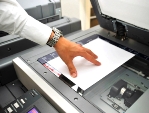
Case Study: Greening the Print Infrastructure for a Large, Regional Bank
BMI+ImageNet helped the bank adopt a reduce, reuse, and recycle attitude in its print environment.
- By Herb Stebbins
- Jan 21, 2011
Most people think that the bulk of the paper pushed in banks is money, but surprisingly, that is not the case. The need for clear paper trails combined with a historically conservative approach to adopting new technologies has made banks one of the more prolific producers of printed material.
In today's economy, they are facing smaller margins as well as more government controls of fee and credit policies — which translate to less revenue. These pressures are compounded by those from customers and regulators who want the industry to reduce waste and become better environmental stewards.
I was recently invited by one of the largest regional banks in the United States to examine its printing system and find out how to reduce its monthly printed pages, determine the environmental impact of the print devices, and gauge print-related costs.
Because of the size and scope of the project, my team at BMI+ImageNet established a controlled pilot at the bank's Service Center facilities, which include two large buildings for customer service and regulatory solutions departments.
The team discovered that while the bank had been using sound purchasing practices and worked hard to get the best pricing and products, the system was not actively managed. Some of the items that needed immediate correction were:
- System visibility. The bank did not have a system that tracked and monitored prints and print devices. It also had many older devices, some of the 20 years old.
- Print device proliferation. Over the years, print devices had accumulated, often being placed where they "fit," not where they were needed for maximum performance. When a device stooped working, it was not decommissioned; it simply was placed in someone’s office. Very few of the devices were Energy-Star compliant.
- Inconsistent recycling. Because of the number of makes/models of print devices and a variety of recycling programs offered by each, it was difficult to track and manage recycling goals.
To better assess the bank's printing needs the team designed a system to benchmark existing costs and print volumes. It implemented a network utility to track the print devices and monitor output. The team performed several more walkthroughs to gather usage detail on non-networked devices, collected and analyzed invoices for print-related expenses, and mapped all of the devices, volumes, and costs on building floor plans to get additional insight into the print environment.
With all this information in hand, we developed the following key system recommendations:
- The print fleet needed to be reduced by 50 percent. Current devices were underutilized, expensive (both to repair and to supply), and difficult to manage from an IT perspective.
- The print fleet needed to be standardized to as few models as possible to aide in supply and support costs. The devices also needed to be as efficient as possible to reduce costs, able to duplex to reduce paper consumption, and highly reliable to reduce downtime.
- Network visibility needed to be 100 percent. All print devices needed to be networked. The right mix of print management software also needed to be installed.
- All devices in the print environment needed to be Energy Star compliant to reduce energy usage. They also needed to be from a manufacturer with a solid recycling program in place.
The final results of this project speak to the value of designing an environmentally sound and efficient print environment. We reduced the overall device count by 52 percent, decreased the number of printed pages by 26 percent, and reduced overall system cost by 34 percent in hard cost savings and 46 percent in hard and soft cost savings.
BMI+ImageNet worked directly with the client to assess the current work environment, find the inefficiencies, refresh the old technology, keep what is working, and implement a green plan for reducing waste and recycling. In the end, the client received one monthly bill that is lower than the current total print cost.
About the Author
Herb Stebbins, managed print specialist, defines, develops, and implements specific action plans that will maximize operational productivity, efficiency, and profitability for BMI+ImageNet clients. He has more than 15 years of progressive sales and management experience.